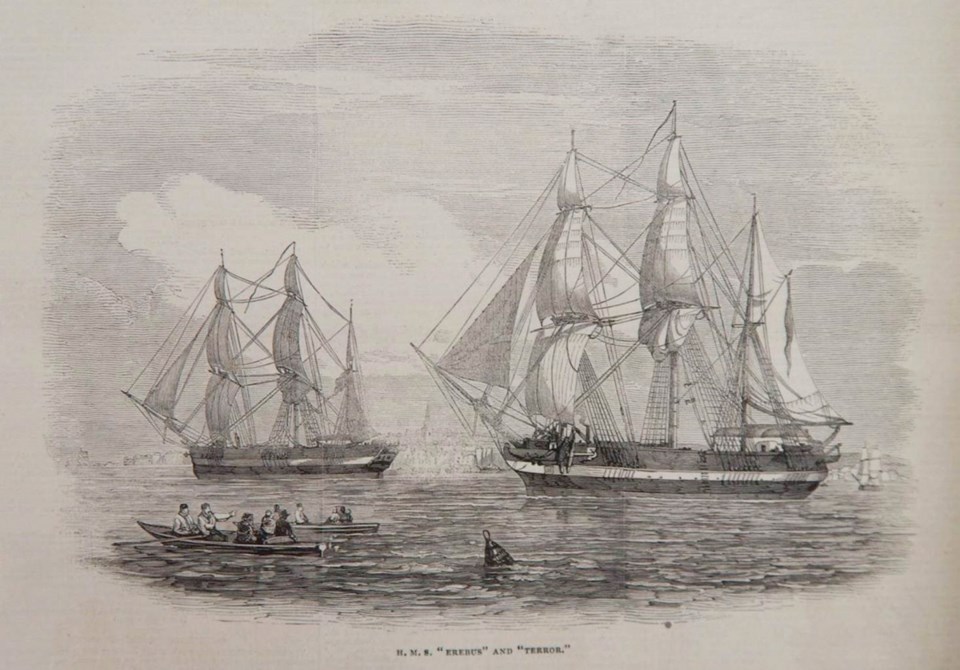A stash of Arctic archeological evidence on the Franklin expedition is going online for would-be investigators interested in the doomed mission.
Coming soon is a website, The Franklin Mystery: Life and Death in the Arctic. It’s the 13th in a national online series called the Great Unsolved Mysteries in Canadian History. It will present original documents and transcripts to give people a chance to come up with their own theories about the fate of the expedition.
The website will be unveiled on Thursday at a special ceremony at the National Library and Archives of Canada in Ottawa.
John Lutz, a history professor at the University of Victoria and a director of the Mysteries project, said it’s not as though people will make new discoveries about the Franklin expedition.
But they can, and will, bring their own fresh perspectives. That means different ways of interpreting the evidence and some plausible theories of their own.
“You and I might look at the same documents and evaluate them completely differently,” he said.
“Then it becomes a matter of critical thinking. That’s the real teaching moment.”
The fate of the Franklin expedition to map the Northwest Passage has become one of the greatest and most persistent mysteries in Canadian history.
Led by Sir John Franklin, two Royal Navy ships set out in 1845 with 129 men, and just disappeared.
Last September, the nearly intact remains of one of Franklin’s ships, HMS Erebus, were discovered in Arctic waters. But Franklin’s other vessel, HMS Terror, remains lost.
Lutz said much of the mystery arises from questions as to why the expedition failed at all. For its time, the Franklin expedition was the best-equipped exploratory mission ever dispatched. The crews were experienced, the ships were well-fitted and carried three year’s worth of food.
It has been likened to the 19th-century version of a NASA moon launch.
By 1848, with no news, people in England were becoming concerned and started sending out search-and-rescue expeditions, more than 30 missions in all.
Guided by Arctic First Nations people, one of the early search parties found a rock cairn on an island. Inside was an account written by Franklin’s senior officers.
The account indicated Franklin had died in May 1847, after two years with the ships stuck in the ice. The surviving crew, about 100 men and officers, abandoned the ships and headed overland, dragging supplies in the ship’s small boats. They deposited their account in the cairn in 1848 and likely continued on for a Hudson’s Bay outpost about 1,600 kilometres away. They never arrived.
Other evidence from First Nations witnesses revealed disturbing news. The witnesses spoke of the crew resorting to cannibalism to survive.
So horrified was 19th-century England at the notion of its own countrymen turning cannibal that much of the evidence from First Nations witnesses was dismissed.
That is what makes Lutz especially proud of the Franklin Mystery website. Unlike other accounts, historical and modern, the website gives good weight to the spoken accounts of aboriginal witnesses.
The witnesses were interviewed by Royal Navy searchers in the 19th century and transcriptions of their accounts are now available to those who look online.
Even Lutz said he was long reluctant to give much historical importance to those recorded accounts of 19th-century First Nations witnesses. He explained that one native account spoke of a ship stuck in the ice with smoke coming out of a stove pipe. Lutz said he saw little of value in the account largely because it placed the ship so far south. Then, HMS Erebus was discovered farther south than earlier searchers had looked or anyone expected. So Lutz started rethinking.
“So now I’m thinking maybe they [Franklin’s crew] didn’t all abandon the ship,” Lutz said. “Or maybe some of the crew turned back and took their chances living in the shelter of the ship.
“Maybe they even started using the ship itself as firewood and slowly cannibalized their own vessel while they waited for rescue rather than searching for a Hudson’s Bay outpost.”
For information about other mysteries, check out Great Unsolved Mysteries in Canadian History at canadianmysteries.ca.



